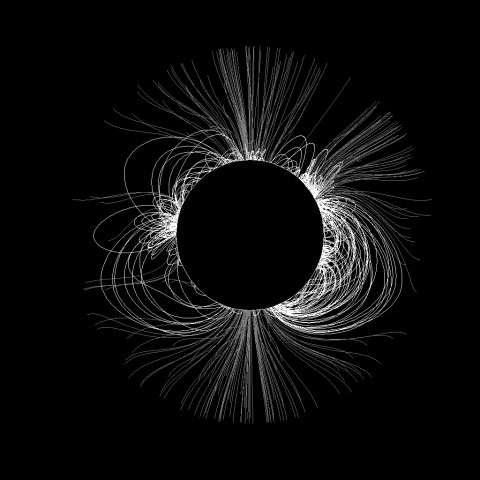National Solar Observatory predicts shape of solar corona for august eclipse

August 21st will bring a history-making opportunity for the entire United States. On that day, every person in the country, including Hawaii and Alaska, will have an opportunity to witness at least a partial solar eclipse as the moon moves in front of the Sun. If you have the good fortune to be along the path of totality, stretching from Oregon to South Carolina, you will get to witness one of the most awe-inspiring views in nature – the wispy wonders of the solar corona.
But there is more to the corona than one might initially realize. Dr. Gordon Petrie from the National Solar Observatory (NSO) explains: "The corona might look like it's a fuzzy halo around the Sun, but it actually has quite a lot of structure to it. The Sun has a magnetic field that, at first glance, might remind us of the middle-school experiment where you sprinkle iron filings over a bar magnet to get a butterfly shape. However, on closer inspection, it is far more complicated than that."
"Since we are exactly one solar rotation away from the solar eclipse, we're able to use today's observations to predict the structure of the corona on Aug. 21st" says Petrie. "The corona is not likely to change too much between now and the eclipse, unless we get lucky and a large active region appears! We expect to see faint, straight structures protruding from the north and south poles of the Sun – these are the polar plumes. We will be able to see brighter bulbs of material closer to the equator – these are called helmet streamers."
The Sun's magnetic field is rooted inside of the Sun, and protrudes through the surface leaving marks we recognize as sunspots. Since we cannot directly observe magnetic fields, we use the super-heated gases present in the Sun's atmosphere to trace out the magnetic field lines, similar to the role of iron filings in the aforementioned bar magnet experiment. Under normal circumstances, the solar corona – the outermost layer of the Sun's atmosphere – is hidden from view by the bright solar surface. During an eclipse, the surface is blocked, allowing the corona to shine through.
"The corona changes its shape over time, and looks drastically different during solar maximum compared to solar minimum," explains Dr. David Boboltz, the National Science Foundation's program officer for the NSO. "During solar maximum, such as the 2012 eclipse, the corona looks like a spiky ring around the entire sun. In contrast, a solar minimum eclipse such as the one this month, will have lots of complexity near the equator but will be drastically different near the north and south poles of the Sun."
The 2017 eclipse will offer a unique opportunity to observe the corona for more than 90 minutes, many times longer than a typical eclipse. However, NSO is preparing to change how we look at the solar corona forever. NSO is leading the charge on constructing the NSF-funded Daniel K. Inouye Solar Telescope, or DKIST, in Maui, Hawaii. Using this observatory, which will house the most powerful solar telescope in the world, scientists will be able to consistently measure the magnetic fields in the solar corona directly for the very first time. "The solar corona is largely an enigma," according to Dr. Valentin Pillet, Director of NSO. "For now, the best we can do is compare high resolution images of the solar corona, such as those we'll obtain during the eclipse, to our theoretical models. But DKIST will allow us to actually measure the magnetic fields in the corona. This will be revolutionary in the field of solar physics."
Provided by National Solar Observatory





















